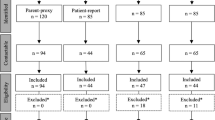Abstract
Background
The aim of the study was to review the degree to which the long-term outcome and ongoing morbidity in Currarino syndrome (CS) has been established.
Methods
Analysis of previously published reports that have included long-term outcome data in CS and review of five additional patients with CS.
Results
Overall, long-term outcomes of children born with CS are not well described. Malignancy has been reported in six children of approximately 300 CS patients: four children with malignancy had a recurrence after primary excision. Malignancy has also occurred in four adults. Ongoing morbidity related to constipation, faecal incontinence, neurogenic bladder, urinary incontinence and presacral abscess, and more rarely meningitis, brain metastases, developmental delay and unusual gait. Almost certainly, previous reports have under-estimated the true incidence of these problems, given the methodology and focus of these series.
Conclusions
There is paucity of information on the long-term outcomes in CS. Few authors have focused on ongoing symptoms, such that we speculate the true incidence of long-term urinary and bowel dysfunction may have been under-estimated in CS. Greater emphasis on the functional assessment of these systems during childhood may help predict the long-term outcome in CS. The most severe cases are diagnosed during infancy and childhood, and these are also the ones who are more likely to have ongoing long-term morbidity.
Similar content being viewed by others
References
Currarino G, Coln D, Votteler T (1981) Triad of anorectal, sacral, and presacral anomalies. AJR Am J Roentgenol 137:395–398
Cretolle C, Pelet A, Sanlaville D et al (2008) Spectrum of HLXB9 gene mutations in Currarino syndrome and genotype-phenotype correlation. Hum Mutat 29:903–910
Emans PJ, Kootstra G, Marcelis CL et al (2005) The Currarino triad: the variable expression. J Pediatr Surg 40:1238–1242
Sen G, Sebire NJ, Olsen O et al (2008) Familial Currarino syndrome presenting with peripheral primitive neuroectodermal tumour arising with a sacral teratoma. Pediatr Blood Cancer 50:172–175
Urioste M, Garcia-Andrade Mdel C, Valle L et al (2004) Malignant degeneration of presacral teratoma in the Currarino anomaly. Am J Med Genet A 128A:299–304
Martucciello G, Torre M, Belloni E et al (2004) Currarino syndrome: proposal of a diagnostic and therapeutic protocol. J Pediatr Surg 39:1305–1311
Tander B, Baskin D, Bulut M (1999) A case of incomplete Currarino triad with malignant transformation. Pediatr Surg Int 15:409–410
O’Riordain DS, O’Connell PR, Kirwan WO (1991) Hereditary sacral agenesis with presacral mass and anorectal stenosis: the Currarino triad. Br J Surg 78:536–538
Norum J, Wist E, Bostad L (1991) Incomplete Currarino syndrome with a presacral leiomyosarcoma. Acta Oncol 30:987–988
Yates VD, Wilroy RS, Whitington GL et al (1983) Anterior sacral defects: an autosomal dominantly inherited condition. J Pediatr 102:239–242
Hunt PT, Davidson KC, Ashcraft KW et al (1977) Radiography of hereditary presacral teratoma. Radiology 122:187–191
Haga Y, Cho H, Shinoda S et al (2003) Recurrent meningitis associated with complete Currarino triad in an adult–case report. Neurol Med Chir (Tokyo) 43:505–508
Thambidorai CR, Muin I, Razman J et al (2003) Currarino triad with dual pathology in the presacral mass: report of a case. Dis Colon Rectum 46:974–977
Samuel M, Hosie G, Holmes K (2000) Currarino triad—diagnostic dilemma and a combined surgical approach. J Pediatr Surg 35:1790–1794
Cavero Vargas E, Plauchu H, Rebaud A et al (1992) Sacrum abnormalities and neural tube closure defect: different manifestations of a same genetic disease? Pediatrie 47:273–277
Garcia-Barcelo MM, Lui VC, So MT et al (2009) MNX1 (HLXB9) mutations in Currarino patients. J Pediatr Surg 44:1892–1898
Lee SC, Chun YS, Jung SE et al (1997) Currarino triad: anorectal malformation, sacral bony abnormality, and presacral mass—a review of 11 cases. J Pediatr Surg 32:58–61
Heij HA, Moorman-Voestermans CG, Vos A et al (1990) Triad of anorectal stenosis, sacral anomaly and presacral mass: a remediable cause of severe constipation. Br J Surg 77:102–104
Volk A, Karbasiyan M, Semmler A et al (2007) Adult index patient with Currarino syndrome due to a novel HLXB9 mutation, c.336dupG (p.P113fsX224), presenting with Hirschsprung’s disease, cephalgia, and lumbodynia. Birth Defects Res A Clin Mol Teratol 79:249–251
Kilickesmez O, Gol IH, Uzun M et al (2006) Complete familial Currarino triad in association with Hirschsprung’s disease: magnetic resonance imaging features and the spectrum of anorectal malformations. Acta Radiol 47:422–426
Baltogiannis N, Mavridis G, Soutis M et al (2003) Currarino triad associated with Hirschsprung’s disease. J Pediatr Surg 38:1086–1089
Cretolle C, Zerah M, Jaubert F et al (2006) New clinical and therapeutic perspectives in Currarino syndrome (study of 29 cases). J Pediatr Surg 41:126–131; discussion 126–131
Lynch SA, Wang Y, Strachan T et al (2000) Autosomal dominant sacral agenesis: Currarino syndrome. J Med Genet 37:561–566
Sakakibara R, Hattori T, Uchiyama T et al (2003) Uroneurological assessment of spina bifida cystica and occulta. Neurourol Urodyn 22:328–334
Ilhan H, Tokar B, Atasoy MA et al (2000) Diagnostic steps and staged operative approach in Currarino’s triad: a case report and review of the literature. Childs Nerv Syst 16:522–524
Ashcraft KW, Holder TM (1974) Hereditary presacral teratoma. J Pediatr Surg 9:691–697
Author information
Authors and Affiliations
Corresponding author
Rights and permissions
About this article
Cite this article
Yoshida, A., Maoate, K., Blakelock, R. et al. Long-term functional outcomes in children with Currarino syndrome. Pediatr Surg Int 26, 677–681 (2010). https://doi.org/10.1007/s00383-010-2615-4
Accepted:
Published:
Issue Date:
DOI: https://doi.org/10.1007/s00383-010-2615-4




